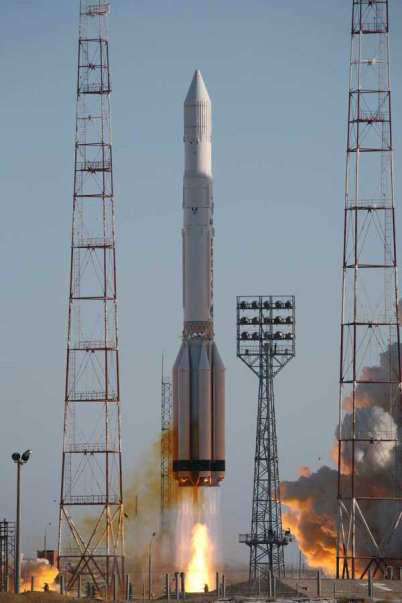Russian Military Satellite Launched by Proton Rocket

A Russian Proton rockethauled a military communications satellite into orbit early Saturday.
Thethree-stage Proton booster, topped by a Block DM upper stage, blasted off at0410 GMT (11:10 p.m. EST Friday) from Complex 81 at the Baikonur Cosmodrome inKazakhstan.
The rocket's Block DM upperstage completed several burns to place mission's payload into a geosynchronoustransfer orbit stretching from an altitude of approximately 136 miles to a highpoint of about 22,000 miles.
The payload, believed to bea Raguda military communications satellite, separated from the Block DM at 1046GMT (5:46 a.m. EST), successfully punctuating the six-and-a-half hour mission,according to Russian defense officials.
Raguda satellites are alsoknown as the Globus series. The craft operate in geosynchronous orbit 22,300miles above the planet to relay critical communications between troops andmilitary leaders.
Saturday's launch was the secondProton mission of 2009, coming two-and-a-half weeks after another Protonrocket delivered two Russian civil communications satellites into space.
The next Proton flight isscheduled for March 28 to launch the W2A communications satellite for Eutelsat.
Get the Space.com Newsletter
Breaking space news, the latest updates on rocket launches, skywatching events and more!
- New Show - NewSpace: The Orbital Industrial Revolution
- Images - 20 Great Rocket Launches
- Video - SpaceX's Falcon 1 Rocket Success!
Copyright 2009 SpaceflightNow.com,all rights reserved.
Join our Space Forums to keep talking space on the latest missions, night sky and more! And if you have a news tip, correction or comment, let us know at: community@space.com.
Stephen Clark is the Editor of Spaceflight Now, a web-based publication dedicated to covering rocket launches, human spaceflight and exploration. He joined the Spaceflight Now team in 2009 and previously wrote as a senior reporter with the Daily Texan. You can follow Stephen's latest project at SpaceflightNow.com and on Twitter.










